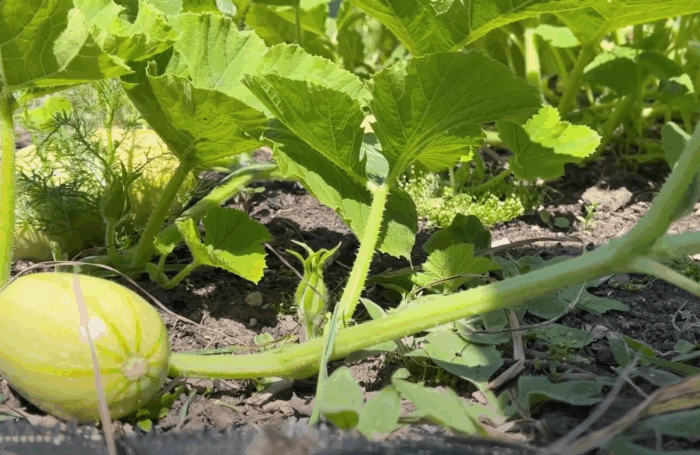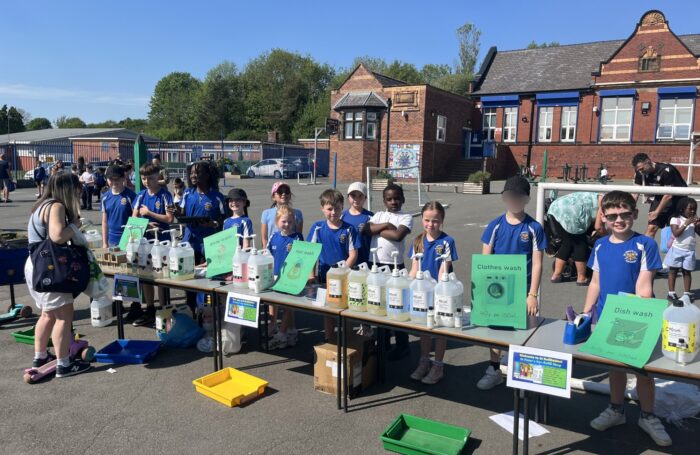From community groups and charities to businesses and schools, we believe that everyone has a role to play in helping nature recovery across Greater Manchester. We’ll be shining a spotlight on the passionate individuals who are already leading the way – our Local Nature Champions.
Kicking us off, we meet Debbie Wallace, Urban Ranger for Southway Housing Trust. Debbie leads several innovative nature recovery projects in Chorlton, focused on turning road-side green spaces from mown grass to biodiverse pocket-sized nature spaces. Her amazing work not is not only improving spaces for nature but is also seeking to engage and inspire the local community, demonstrating the potential for communal greenspaces in estates that need them most.
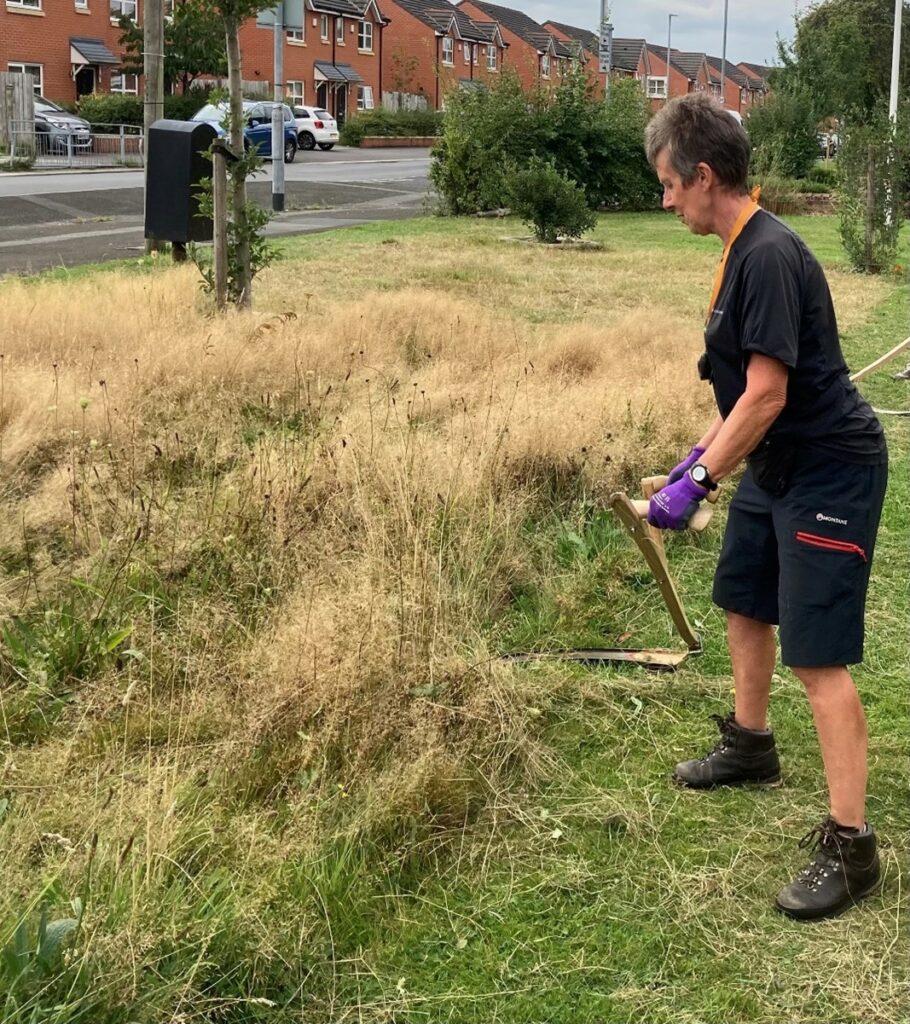
How did you first get involved in nature recovery?
I have loved nature for a long as I can remember. My mother tells me that my first word was “bird” and I feel rather proud of that. When I became a homeowner, I started by creating a wildlife friendly garden to provide resources and habitat for as many types of flora and fauna as I could in a small suburban garden. I spread this to my allotment and to my mother’s garden, and now that I have the privilege of working for a Social Housing provider and landowner with a strong commitment to the environment I can spread this further. Through Southway Housing, I now have the opportunity to create nature spaces which work for nature and for people in suburban green spaces.
I have been a keen participant in projects lead by the Greater Manchester Local Record Centre for many years, I have volunteered and worked with the Greater Manchester Ecology Unit and as my interest in nature increased, my awareness of its plight also increased. My desire to learn and understand more lead to studying for an MSC in Biological Recording with an emphasis on Botany and my dissertation focussed on habitat restoration. I am passionate about nature recovery and helping to protect and restore habitats for nature.
Tell us more about the nature recovery projects you are involved in.

I am leading some nature recovery projects in public green spaces in Chorlton and want to focus on two of them. The common feature of these sites is that they are located on road-side green spaces which belong to Southway Housing Trust. They are very accessible to passing public and are next to houses. These sites have been transformed from mown grass to biodiverse pocket-sized nature spaces which also need to work for people. Both sites have paths which guide people in to explore and enjoy connection with nature.
- Wintermans Road Woodland is approximately 100m long and 9m wide and planting started in December 2021. At the time of writing, it is in its second growing season and really has to be seen to be believed. In February 2021, the site was just a mown grass verge with some mature trees along the boundary and two years later, it has woodland plants covering much of the ground, a young, developing understory with woodland shrubby species and two densely planted areas which will form dense scrub for birds to nest in. The tree canopy is a mixture of newly planted native trees and the existing mature trees which were already along the boundary.
- Darley Avenue wildlife zone is part of a Green Flag site* in Chorlton. A significant feature of this site is the six experimental wildflower meadow plots. These were initially created with the help of residents in 2020. Each of the plots has had a different treatment and because the species present on each of the plots has been recorded each year, we have a record of how each of the plots has changed over the last three growing seasons. This information helps to inform how we manage the plots to increase the quantity and diversity of wildflower species. The plots are scythed at the end of August each year and this, together with seed collecting and sowing are great activities to get the local community and volunteers involved in. The site also has a community fruit bush hedge with thornless Blackberries and autumn fruiting Raspberries. These are equally popular with Bumblebees, Hoverflies, Shieldbugs, Blackbirds and people.
* The Green Flag Award recognises and rewards well managed parks and green spaces, setting the benchmark standard for the management of recreational outdoor spaces.
What do you think nature offers Greater Manchester?
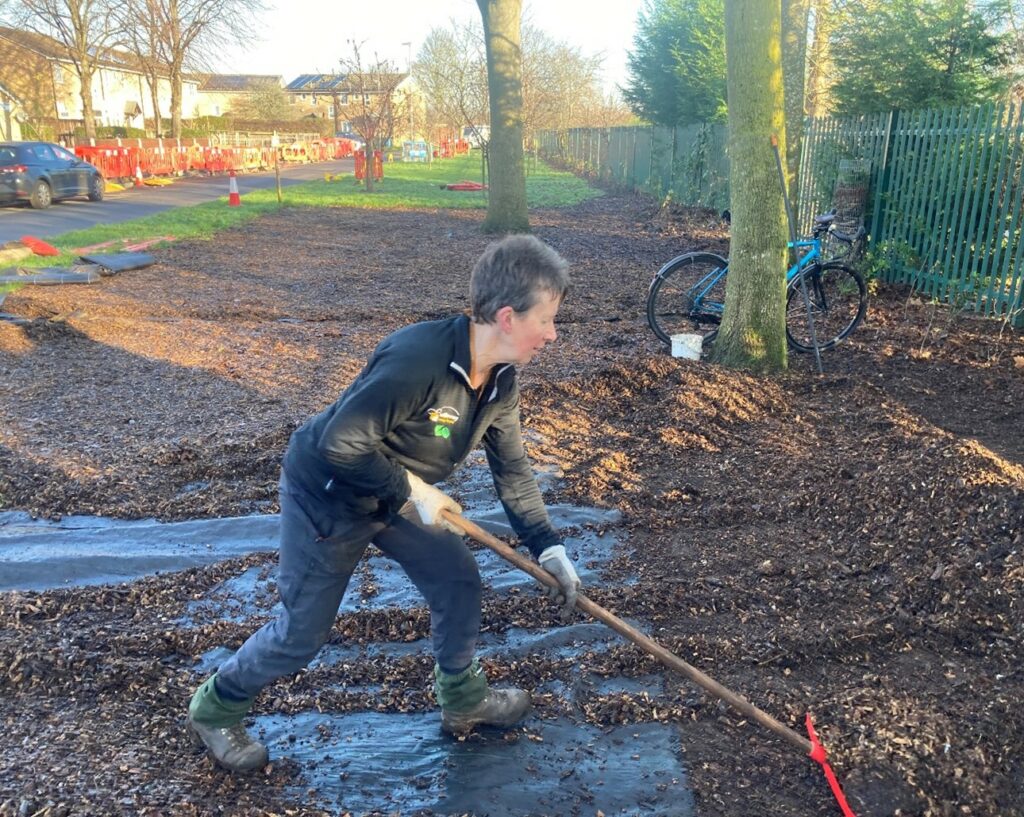
I think the primary focus should actually be on what Greater Manchester can offer nature. We are the guardians of the spaces which nature desperately needs to survive and thrive. Many species are declining and some are in danger of being lost: we need to help nature to recover.
What does nature offer Greater Manchester? I could list all the usual environmental benefits, the ecosystem services: the carbon sequestration and storage, temperature regulation, reduction of air pollution and water runoff, the pollination of plants (including many food crops) and the benefits of contact with nature to our physical and mental health.
If you want my view of what nature offers Greater Manchester, picture this… you step outside your home and you walk along a pavement, you see roads, buildings, cars, buses, a few wheelie bins, some other people, you pass by shops, a car park, you cross a road to your bus stop. On your way, you see hardly anything which is green apart from some grass growing between the paving flags which has been sprayed with weedkiller, there is no sign of insects, the only birds are flying high and flying away. You travel on a bus, everything out of the window looks lifeless. The bus stops outside your workplace and you go into the building. When you sit at your desk, you look out of the window at a bare concrete building. From leaving your home, your experience has been devoid of nature.
Alternatively, you live on Wintermans Road. You step outside your home, cross the road and walk along the grass path between the community orchard trees, on your left is the allotment site. You can hear the grasshoppers chirping in the long grass and see the Bumblebees visiting Dog Rose flowers. The Bumblebees are buzzing vigorously to release the pollen. A Speckled Wood Butterfly is sunning itself on a Bramble leaf to warm up before it forages. At the end of the grass path, you enter the small strip of woodland which has been created on what was once a grass verge, the first thing that hits you is the sweet perfume of Bluebells. The air feels cooler under the newly unfurling tree canopy and the sound of Robin song is belting out from one of the tree branches. A male blackbird with a beak full of worms dashes across the path in front of you and a squirrel runs up a tree trunk as you approach. At the bird bath a female Blackbird is bathing and throwing water all over the path. You wait until she finishes to avoid disturbing her. As you walk past the Red Campion plants, you take a quick peek at the flowers before leaving the woodland path. This is the first part of your journey to work.
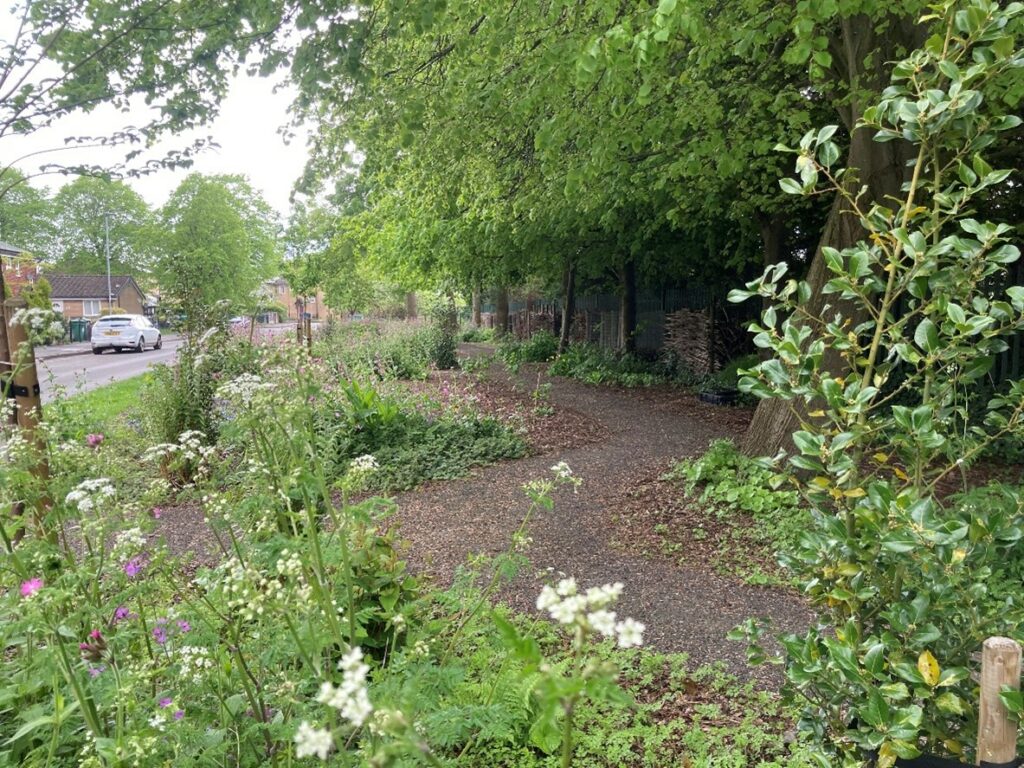
Or you could live on Darley Avenue. You step outside your home, cross the path and pick some of the Raspberries from the community fruit bush hedges to eat on your way to the bus stop. You see a Hairy Shield bug on the bush and make sure that you don’t pick that with your Raspberries. The Knapweed plants in the wildflower meadow plots have gone to seed and Goldfinches are using their fine beaks to reach the nutritious seeds. You hear the persistent begging call of the juvenile birds pestering the adults for food. You walk along the mown path through the wildflower plots taking in the buzzing, humming and chirping of noisier invertebrates and spot a Thick-legged Flower Beetle on a flower. These comical looking beetles always make you smile. Your route takes you along Mottram Avenue with its wide verges with Oak and Poplar trees. You see young acorns growing on the Oaks and notice a caterpillar in the rough furrowed bark of a Poplar tree. You spot the first signs of a fairy ring of mushrooms in the grass. The last thing you hear as you reach your bus stop is a Nuthatch calling from one of the Poplars.
The last two accounts are what I experience when I work at these green spaces and I want everyone to have the chance to experience this. Nature offers Greater Manchester a better life.

Why do you think it’s important more people get involved in nature?
I strongly believe that nature is important for people and people are important for nature.
When people get involved in nature it benefits their own wellbeing and at the same time, it increases their awareness that we can have a positive impact on nature. Getting people involved in nature improves understanding and fosters care. Nature is often at the mercy of human actions and sometimes protecting nature or creating places for nature is not the most convenient choice for us. If we are involved in nature and if we care about it, we are far more likely to make the right choice for nature.
The more people who take positive steps to help nature, the more can be achieved. It does not always have to be on a large scale: small projects in small spaces can make a big difference.
What do you think is the single greatest priority for nature recovery in Greater Manchester?
To protect what we have already got and to ensure that recovery projects get it right and are fit for purpose.
Knowing what is where is key to protecting it and this requires competent recording to get accurate records of what is where. Protecting SBIs, AWIs and good grassland habitats is essential. These cannot be compensated for if they are lost or degraded. They are too precious to lose.
Nature recovery projects must take place in appropriate locations to avoid damaging something which is already important. They must be well considered and appropriate for the location.
Protect and get it right.
And how would you address that priority if time and resources weren’t an issue?
- Get competent people to sites to survey and record the species and habitats. Botanical records and invertebrate records are needed in addition to protected species and priority habitats. The recorders need to have good competence to provide reliable records. It is likely that several specialists will need to record at a site.
- Collate and evaluate and map the records to visualise where the habitats and species are.
- Flag up the places which are good and need to be protected as they are. It is important to know this to protect them from detrimental change or degradation.
- Flag up the places where good habitat is declining and needs action to restore to prevent species loss. This informs the right action in the right place.
- Flag up the places with species which are threatened or declining and need protection or intervention to prevent loss.
- Identify suitable sites for habitat improvement to ensure that nature recovery takes place in the right place and the right habitat is created for the appropriate species.
- Identify opportunities for habitat linkage to allow species dispersal.
- Coordination of nature recovery projects and species reintroductions to make sure that organisations are aware of what others are doing (and planning to do). Map the projects and link to the organisation.
- Create a central information hub with an overview of nature recovery and provide an advice centre for organisations and landowners wanting to “do their bit” and need advice about what is the most practical nature recovery action for their land and potentially link to organisations who can deliver or help deliver this.
- Map landownership to show who can make decisions about the land management and use.
How can people get involved?
To volunteer with Debbie on her project spaces in Chorlton or to join a mailing list for further information about guided nature walks and nature-based activities / workshops, contact d.wallace@southwayhousing.co.uk.
Find out more about our plan for nature recovery
Greater Manchester is currently developing its Local Nature Recovery Strategy, which will set out a blueprint for a more liveable city-region, with fairer access to green space for all.
Find out more including ways to get involved on our nature recovery webpage.